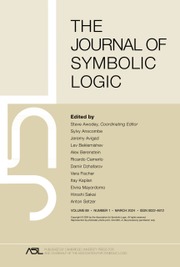Crossref Citations
This article has been cited by the following publications. This list is generated based on data provided by Crossref.
Benoist, Franck
2002.
Rangs et types de rang maximum dans les corps différentiellement clos.
Journal of Symbolic Logic,
Vol. 67,
Issue. 3,
p.
1178.
Altınel, Tuna
and
Cherlin, Gregory
2005.
Limoncello.
Journal of Algebra,
Vol. 291,
Issue. 2,
p.
373.
Hasson, Assaf
2007.
Interpreting structures of finite Morley Rank in strongly minimal sets.
Annals of Pure and Applied Logic,
Vol. 145,
Issue. 1,
p.
96.
FRÉCON, OLIVIER
2008.
CONJUGACY OF CARTER SUBGROUPS IN GROUPS OF FINITE MORLEY RANK.
Journal of Mathematical Logic,
Vol. 08,
Issue. 01,
p.
41.
Blossier, T.
and
Martin-Pizarro, A.
2009.
Sur les collapses de corps différentiels colorés en caractéristique nulle décrits par Poizat à l'aide des amalgames à la Hrushovski.
Journal of the Institute of Mathematics of Jussieu,
Vol. 8,
Issue. 3,
p.
445.
Aschenbrenner, Matthias
Dolich, Alf
Haskell, Deirdre
Macpherson, Dugald
and
Starchenko, Sergei
2013.
Vapnik–Chervonenkis Density in Some Theories without the Independence Property, II.
Notre Dame Journal of Formal Logic,
Vol. 54,
Issue. 3-4,
Bays, Martin
Gavrilovich, Misha
and
Hils, Martin
2014.
Some Definability Results in Abstract Kummer Theory.
International Mathematics Research Notices,
Vol. 2014,
Issue. 14,
p.
3975.
Pillay, Anand
2017.
The Picard–Vessiot theory, constrained cohomology, and linear differential algebraic groups.
Journal de Mathématiques Pures et Appliquées,
Vol. 108,
Issue. 6,
p.
809.
Pong, Wai Yan
2017.
Logic Colloquium '03.
p.
232.
DeVilbiss, Matthew
and
Freitag, James
2023.
Generic differential equations are strongly minimal.
Compositio Mathematica,
Vol. 159,
Issue. 7,
p.
1387.

